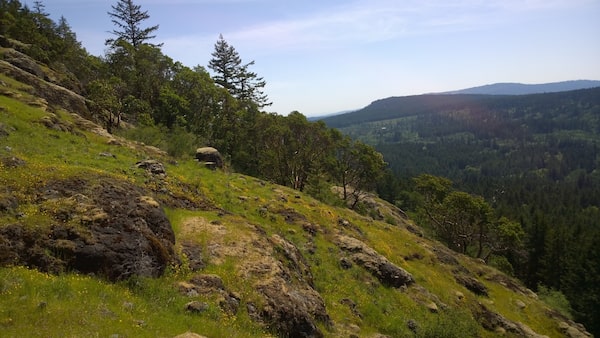
British Columbia’s newest provincial park in the Cowichan Valley on Vancouver Island covers 143 hectares of land. The new park, along with expansions of existing provincial parks, allows B.C. to say it has one of the highest percentages of its land base protected – 14.4 per cent – among Canadian provinces.Handout
British Columbia’s newest provincial park, in the Cowichan Valley on Vancouver Island, packs a lot of ecosystem values into 143 hectares of land: It includes sensitive grasslands, rare plant species, a remnant old-growth Douglas fir forest and limestone karst features. It is home to threatened wildlife species, including Roosevelt elk, western screech owls and northern goshawks.
The new park, named Hwsalu-utsum by the Cowichan Tribes, who have identified the area for its spiritual and cultural importance, will be created by proposed legislation introduced on Oct. 5, along with expansions of nine existing parks that together add more than 2,200 hectares to the province’s protected areas. The additions allow B.C. Environment Minister George Heyman to say his province has one of the highest percentages of its land base – 14.4 per cent – dedicated to protected areas of all provincial Canadian jurisdictions.
Earlier this year, the Intergovernmental Panel on Climate Change (IPCC) issued a report that confirmed that nature and climate are inextricably linked: Biodiversity loss and climate change are both driven by human economic activities and mutually reinforce each other, and must be tackled together. When Canada talks up its progress on climate change ahead of the UN Climate Change Conference meeting that starts on Oct. 31 in Glasgow, Scotland, it will point to its work on biodiversity as one of its accomplishments. Mr. Heyman also frames the province’s climate action plan as a way to “transition to a cleaner economy that supports the biodiversity and healthy ecosystems we need to survive and to thrive.”
Mr. Heyman is expected to join the Canadian delegation at the climate change conference, where Canada will have to deliver a progress report on its commitment to conserving or protecting at least 30 per cent of its lands, inland waters and coastal and marine areas by 2030. There are interim targets, to reach 25-per-cent protection by 2025, and so far there has been no accord with the provinces to map out how Canada will achieve its goals.
British Columbia isn’t ideologically opposed to the federal agenda, but at the same time, has not signed on to the international pledge to conservation.
And for Canada to meet its targets, British Columbia has to play a major role, because it holds such a large share of the country’s biodiversity. “Of all the Canadian provinces and territories, B.C. is home to the richest diversity of vascular plants, mosses, mammals, butterflies and breeding birds, and the largest number of species of reptiles, tiger beetles and amphibians found only in one province or territory,” according to Nature Trust BC, a non-profit land conservation organization that has acquired hundreds of properties. All that biodiversity is great, but B.C. also has the most to lose: Of the 3,808 native species that have been assessed, 43 per cent are listed as a conservation concern.
The chances of reaching an accord before the UN conference in Glasgow are slim.
Prime Minister Justin Trudeau says he intends to name his new cabinet this month. Before the Sept. 20 election, the Environment portfolio was held by B.C.-based Jonathan Wilkinson, who sought to bring his home province on board by putting cash on the table to protect old-growth forests that are a key to Canada’s targets. The federal Liberals promised $50-million to buy old-growth forests in B.C. to stop logging. But the election campaign put any potential talks on hold, and the limbo continues as Mr. Trudeau assembles his new cabinet.
While B.C. stonewalls on Mr. Wilkinson’s potential fund for old-growth protection, it continues to take heat for lack of progress on its own commitments to protect forests, which are crucial to biodiversity.
While Mr. Heyman introduced his parks legislation on Tuesday, protesters blocked most entrances to the legislature to voice their concern that the province continues to approve logging of ancient forests, even as it deliberates where it will defer such logging. The Green caucus amplified those voices.
In Question Period, Green Leader Sonia Furstenau noted that the NDP committed to old-growth protections a year ago, during the provincial election campaign. “Where are we at a year later? As of May, this government’s approvals of logging of old growth increased 43 per cent over the previous year.”
Of course, the province doesn’t want to talk about conservation of old-growth forests in Glasgow. It wants to highlight its CleanBC program, which was revamped on Sept. 28 as a five-year plan to make it easier and more affordable for people to efficiently use more of B.C.’s clean electricity in place of fossil fuels in their homes and buildings, businesses and vehicles.
With the climate change conference just weeks away, Canada says it is on track to meet its conservation targets, through the nature investments made in the last federal budget. The provincial and federal ministers are heading to Glasgow with, at best, compatible but different score sheets.
We have a weekly Western Canada newsletter written by our B.C. and Alberta bureau chiefs, providing a comprehensive package of the news you need to know about the region and its place in the issues facing Canada. Sign up today.
 Justine Hunter
Justine Hunter